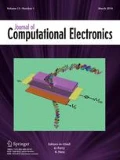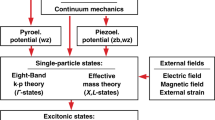Abstract
Electronic structure and optical properties of self-assembled quantum dots strongly depend on an intricate interplay of the quantum mechanical size quantization and the atomistic built-in/internal electrostatic fields in the underlying material system. Specifically, built-in fields in zincblende quantum dots originate mainly from: (1) fundamental crystal atomicity and the interfaces between two dissimilar materials, (2) microscopic distribution of strain, and (3) the piezoelectric polarization. In this paper, we first study the origin and nature of these internal fields in InAs/GaAs quantum dots having three different geometries, namely, box, dome, and pyramid. We then quantify and delineate the impact of these internal fields on the one-particle electronic states in terms of symmetry-lowering and localization in the wavefunctions, shift in the energy states and bandgap, anisotropy and non-degeneracy in the \(P\) level, and formation of mixed excited bound states near the Brillouin zone center. Finally, we study the geometry and size-dependence of interband optical transitions in the XY and XZ planes treating the quantum size quantization and the internal fields as parameters. The computational framework employs a combination of fully atomistic valence force-field molecular mechanics, 20-band nearest-neighbor \(sp^{3} d^{5} s^{*}\) tight-binding electronic bandstructure models, and appropriate post-processing tools to obtain the interband optical transition rates. In particular, to model piezoelectricity, four different polarization models (based on the experimental and ab initio coefficients accounting for both linear and non-linear effects) have been considered in increased order of accuracy. With the non-linear piezoelectricity generally opposing the linear counterpart, the net piezoelectric field is found to be negligible in smaller dots but exhibits non-vanishing effects as the dot height is increased.















Similar content being viewed by others
References
Petroff, P.M.: Epitaxial growth and electronic structure of self-assembled quantum dots. In: Michler, P. (ed.) Single Quantum Dots: Fundamentals, Applications, and New Concepts. Springer, Berlin (2003)
Rastelli, A., Kiravittaya, S., Schmidt, O.G.: Growth and control of optically active quantum dots. In: Michler, P. (ed.) Single Semiconductor Quantum Dots. Springer, Berlin (2009)
Wang, Z.M., Liang, B., Sablon, K.A., Lee, J., Mazur, Y.I., Strom, N.W., Salamo, G.J.: Self-organization of InAs quantum-dot clusters directed by droplet homoepitaxy. Small 3(2), 235–238 (2007)
Michler, P., Kiraz, A., Becher, C., Schoenfeld, W.V., Petroff, P.M., Zhang, Lidong, Hu, E., Imamoglu, A.: A quantum dot single-photon turnstile device. Science 290, 2282–2285 (2000)
Bhowmick, S., Baten, M.Z., Frost, T., Ooi, B.S., Bhattacharya, P.: High performance \(\text{ InAs/In }_{0.53}\text{ Ga }_{0.23}\text{ Al }_{0.24}\text{ As/InP }\) quantum dot 1.55 \(\mu \)m tunnel injection laser. IEEE J. Quantum Electron. 50(1), 7–14 (2014)
Loss, D., DiVincenzo, D.P.: Quantum computation with quantum dots. Phys. Rev. A 57, 120–126 (1998)
Friesen, M., Rugheimer, P., Savage, D., Lagally, M., van der Weide, D., Joynt, R., Eriksson, M.: Practical design and simulation of silicon-based quantum-dot qubits. Phys. Rev. B 67, 121301 (2003)
Bester, G., Zunger, A.: Cylindrically shaped zinc-blende semiconductor quantum dots do not have cylindrical symmetry: atomistic symmetry, atomic relaxation, and piezoelectric effects. Phys. Rev. B 71, 045318 (2005)
Marzin, J.-Y., Gérard, J.-M., Izraël, A., Barrier, D., Bastard, G.: Photoluminescence of single InAs quantum dots obtained by self-organized growth on GaAs. Phys. Rev. Lett. 73, 716–719 (2000)
Klimeck, G., Ahmed, S., Kharche, N., Bae, H., Clark, S., Haley, B., Lee, S., Naumov, M., Ryu, H., Saied, F., Prada, M., Korkusinski, M., Boykin, T.B.: Atomistic simulation of realistically sized nanodevices using NEMO 3-D: Part I—Models and benchmarks. IEEE Trans. Electron Devices 54(9), 2079–2089 (2007)
Klimeck, G., Ahmed, S., Kharche, N., Korkusinski, M., Usman, M., Prada, M., Boykin, T.B.: Atomistic simulation of realistically sized nanodevices using NEMO 3-D: Part II—Applications. IEEE Trans. Electron Devices 54(9), 2090–2099 (2007)
Pryor, C., Kim, J., Wang, L.W., Williamson, A.J., Zunger, A.: Comparison of two methods for describing the strain profiles in quantum dots. J. Appl. Phys. 83, 2548 (1998)
Grundmann, S.M., Bimberg, D.: Electronic and optical properties of strained quantum dots modeled by 8-band kp theory. Phys. Rev. B 59, 5688–5701 (1999)
Williamson, J., Wang, L.W., Zunger, Alex: Theoretical interpretation of the experimental electronic structure of lens-shaped self-assembled InAs/GaAs quantum dots. Phys. Rev. B 62, 12963–12977 (2000)
Grundmann, M., Stier, O., Bimberg, D.: InAs/GaAs pyramidal quantum dots: strain distribution, optical phonons, and electronic structure. Phys. Rev. B 52, 11969–11981 (1995)
Hossain, M.Z., Medhekar, N.V., Shenoy, V.B., Johnson, H.T.: Enhanced quantum confinement due to nonuniform composition in alloy quantum dots. Nanotechnology 21, 095401 (2010)
Vastola, G., Zhang, Y.-W., Shenoy, V.B.: Experiments and modeling of alloying in self-assembled quantum dots. Curr. Opin. Solid State Mater. Sci. 16(2), 64–70 (2012)
Jancu, J.M., Scholz, R., Beltram, F., Bassani, F.: Empirical \(spds^{\ast }\) tight-binding calculation for cubic semiconductors: general method and material parameters. Phys. Rev. B 57, 6493 (1998)
Ahmed, S., Kharche, N., Rahman, R., Usman, M., Lee, S., Ryu, H., Bae, H., Clark, S., Haley, B., Naumov, M., Saied, F., Korkusinski, M., Kennel, R., Mclennan, M., Boykin, T.B., Klimeck, G.: Multimillion atom simulations with NEMO 3-D. In: Meyers, R. (ed.) Encyclopedia of Complexity and Systems Science, pp. 5745–5783. Springer, New York (2009)
Boykin, T.B., Klimeck, G., Bowen, R.C., Oyafuso, F.: Diagonal parameter shifts due to nearest-neighbor displacements in empirical tight-binding theory. Phys. Rev. B 66, 125207 (2002)
Klimeck, G., Oyafuso, F., Boykin, T.B., Bowen, R.C., von Allmen, P.: Development of a nanoelectronic 3-D (NEMO 3-D) simulator for multimillion atom simulations and its application to alloyed quantum dots. J. Comput. Model. Eng. Sci. 3, 601–642 (2002)
Lazarenkova, O.L., Allmen, P., Oyafuso, F., Lee, S., Klimeck, G.: Effect of anharmonicity of the strain energy on band offsets in semiconductor nanostructures. Appl. Phys. Lett. 85, 4193–4195 (2004)
Graf, M., Vogl, P.: Electromagnetic fields and dielectric response in empirical tight-binding theory. Phys. Rev. B 51, 4940–4949 (1995)
Boykin, T.B., Bowen, R.C., Klimeck, G.: Electromagnetic coupling and gauge invariance in the empirical tight-binding method. Phys. Rev. B 63, 245314 (2001)
Boykin, T.B., Vogl, P.: Dielectric response of molecules in empirical tight-binding theory. Phys. Rev. B 65, 035202 (2001)
Haley, B.P., Lee, S., Luisier, M., Ryu, H., Saied, F., Clark, S., Bae, H., Klimeck, G.: Advancing nanoelectronic device modeling through peta-scale computing and deployment on nanoHUB. J. Phys. 180, 012075 (2009)
Bester, G., Wu, X., Vanderbilt, D., Zunger, A.: Importance of second-order piezoelectric effects in zincblende semiconductors. Phys. Rev. Lett. 96, 187602 (2006)
Bester, G., Zunger, A., Wu, X., Vanderbilt, D.: Effects of linear and nonlinear piezoelectricity on the electronic properties of InAs/GaAs quantum dots. Phys. Rev. B 74, 081305 (2006)
Ahmed, S., Islam, S., Mohammed, S.: Electronic structure of InN/GaN quantum dots: multimillion atom tight-binding simulations. IEEE Trans. Electron Devices 57(1), 164–173 (2010)
Yalavarthi, K., Chimalgi, V., Ahmed, S.: How important is nonlinear piezoelectricity in wurtzite GaN/InN/GaN disk-in-nanowire LED structures? Opt. Quantum Electron. 46, 925–933 (2014)
Sundaresan, S.S., Gaddipati, V.M., Ahmed, S.S.: Effects of spontaneous and piezoelectric polarization fields on the electronic and optical properties in GaN/AlN quantum dots: multimillion-atom \(sp^{3} d^{5} s^{\ast }\) tight-binding simulations. Int. J. Numer. Model. 2, (2014). doi:10.1002/jnm.2008
Merill, K., Yalavarthi, K., Ahmed, S.: Giant growth-plane optical anisotropy in c-plane wurtzite GaN/InN/GaN dot-in-nanowires. Superlattices Microstruct. 52(5), 949–961 (2012)
Sundaresan, S., Islam, S., Ahmed, S.: Built-in electric fields in InAs/GaAs quantum dots: geometry dependence and effects on the electronic structure. In: Technical proceedings of IEEE nanotechnology materials and devices conferences (NMDC), California, USA, pp. 30–35 12–15 Oct 2010
Ahmed, S., Yalavarthi, K., Gaddipati, V., Muntahi, A., Sundaresan, S., Mohammed, S., Islam, S., Hindupur, R., John, D., Ogden, J.: Quantum atomistic simulations of nanoelectronic devices using QuADS. In: Vasileska, D., Goodnick, S.M. (eds.) Nano-electronic Devices: Semiclassical and Quantum Transport Modeling, pp. 405–441. Springer, New York (2011)
Ahmed, S., Usman, M., Heitzinger, C., Rahman, R., Schliwa, A., Klimeck, G.: Atomistic simulation of non-degeneracy and optical polarization anisotropy in zincblende quantum dots. In: Technical proceedings of the 2nd IEEE international conference on nano/micro engineered and molecular systems, Bangkok, pp. 937–942, 16–19 Jan 2007
Usman, M., Tan, Y.-H.M., Ryu, H., Ahmed, S.S., Krenner, H.J., Boykin, T.B., Klimeck, G.: Quantitative excited state spectroscopy of a single InGaAs quantum dot molecule through multi-million atom electronic structure calculations. Nanotechnology 22, 315709 (2011)
Andreev, D., O’Reilly, E.P.: Optical matrix element in InAs/GaAs quantum dots: dependence on quantum dot parameters. Appl. Phys. Lett. 87, 213106 (2005)
Ryu, H., Nam, D., Ahn, B.-Y., Lee, J.R., Cho, K., Lee, S., Klimeck, G., Shin, M.: Optical TCAD on the net: a tight-binding study of inter-band light transitions in self-assembled InAs/GaAs quantum dot photodetectors. Math. Comput. Model. 58, 288–299 (2013)
Acknowledgments
This work is supported by The US National Science Foundation Grant No. 1102192. Computational resources on XSEDE and ORNL Jaguar (through the 2009 ORAU HPC Award) platforms were used for part of this work.
Author information
Authors and Affiliations
Corresponding author
Rights and permissions
About this article
Cite this article
Ahmed, S., Sundaresan, S., Ryu, H. et al. Multimillion-atom modeling of InAs/GaAs quantum dots: interplay of geometry, quantization, atomicity, strain, and linear and quadratic polarization fields. J Comput Electron 14, 543–556 (2015). https://doi.org/10.1007/s10825-015-0682-4
Published:
Issue Date:
DOI: https://doi.org/10.1007/s10825-015-0682-4




